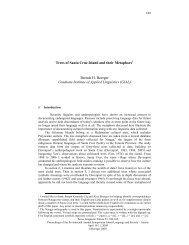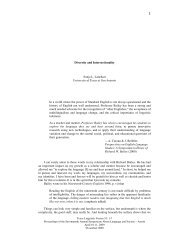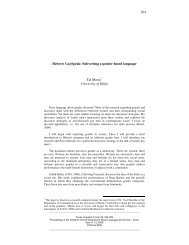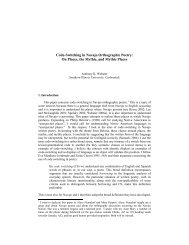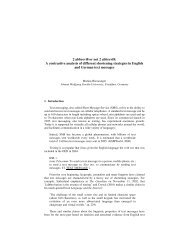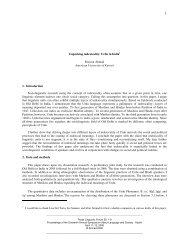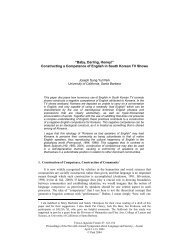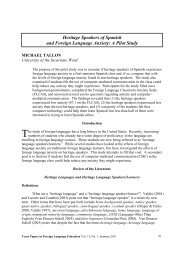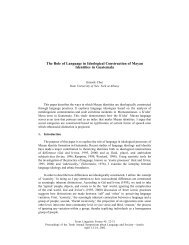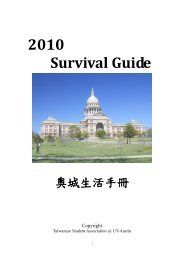The Impact of Bilingual Education on Indigenous Language and ...
The Impact of Bilingual Education on Indigenous Language and ...
The Impact of Bilingual Education on Indigenous Language and ...
Create successful ePaper yourself
Turn your PDF publications into a flip-book with our unique Google optimized e-Paper software.
preparing Tapirape leaders to deal with the invaders as quickly as possible. Currently,<br />
however, the school includes both elementary <strong>and</strong> high school levels. <str<strong>on</strong>g>The</str<strong>on</strong>g> language <str<strong>on</strong>g>of</str<strong>on</strong>g><br />
instructi<strong>on</strong> is Tapirape, all teachers are Tapirape, <strong>and</strong> there are specific schedules for<br />
classes in Tapirape <strong>and</strong> in Portuguese as a sec<strong>on</strong>d language. Students leave school<br />
competent in reading <strong>and</strong> writing both Tapirape <strong>and</strong> Portuguese (Dias de Paula, 2000).<br />
Since 2006, roughly half <str<strong>on</strong>g>of</str<strong>on</strong>g> the Tapirape students who have applied to attend Brazilian<br />
universities have been accepted after passing Portuguese pr<str<strong>on</strong>g>of</str<strong>on</strong>g>iciency exams.<br />
If we compare the Tapirape school with other, less successful indigenous schools<br />
in Brazil, we can identify specific factors that c<strong>on</strong>tribute to the Tapirape success. First, the<br />
school was originally requested by the Tapirape people, rather than being initiated by n<strong>on</strong>governmental<br />
organizati<strong>on</strong>s or imposed by missi<strong>on</strong>aries, as was the case for the Xavante<br />
<strong>and</strong> others cited above. <str<strong>on</strong>g>The</str<strong>on</strong>g> Tapirape school is thus not associated with the cultural<br />
violence <str<strong>on</strong>g>of</str<strong>on</strong>g> missi<strong>on</strong>aries. Although its founding was related to the struggle over l<strong>and</strong>, we<br />
can assume that school has a political <strong>and</strong> symbolic significance for the Tapirape, since the<br />
fight for traditi<strong>on</strong>al l<strong>and</strong>s has meant the fight for Tapirape survival. Sec<strong>on</strong>d, the respectful<br />
attitudes <str<strong>on</strong>g>of</str<strong>on</strong>g> the school’s n<strong>on</strong>-Tapirape founders have been an essential part <str<strong>on</strong>g>of</str<strong>on</strong>g> its<br />
development. <str<strong>on</strong>g>The</str<strong>on</strong>g>se founders worked ‘with’ the Tapirape rather than ‘for’ them; they<br />
listened to the views <strong>and</strong> wishes <str<strong>on</strong>g>of</str<strong>on</strong>g> the Tapirape, <strong>and</strong> they respected the indigenous sense<br />
<str<strong>on</strong>g>of</str<strong>on</strong>g> time – requiring l<strong>on</strong>g deliberati<strong>on</strong> for all decisi<strong>on</strong>s - <strong>and</strong> the choices made by the<br />
Tapirape, even when these decisi<strong>on</strong>s were c<strong>on</strong>trary to the founders’ own points <str<strong>on</strong>g>of</str<strong>on</strong>g> view.<br />
Currently, too, each decisi<strong>on</strong> regarding the school is discussed by the Tapirape community<br />
in meetings that can take up to several days. <str<strong>on</strong>g>The</str<strong>on</strong>g> community decides who should be the<br />
teachers, who should be the director, how to organize the school budget, where the school<br />
should be built, what kind <str<strong>on</strong>g>of</str<strong>on</strong>g> calendar the school should have, <strong>and</strong> virtually every other<br />
issue relating to the school. An important example <str<strong>on</strong>g>of</str<strong>on</strong>g> the founders’ respect for Tapirape<br />
wishes is the following. As menti<strong>on</strong>ed above, the curriculum was first c<strong>on</strong>ceived with the<br />
reality <str<strong>on</strong>g>of</str<strong>on</strong>g> Tapirape life <strong>and</strong> culture in mind. In order to include Tapirape community<br />
activities – with the assumpti<strong>on</strong> that these are also part <str<strong>on</strong>g>of</str<strong>on</strong>g> the students’ educati<strong>on</strong> – the<br />
curriculum was originally designed to be quite flexible in order to allow students to spend<br />
more time with their families. In the beginning, for example, classes were not held every<br />
day. Although this seemed to be the best way to respect, promote <strong>and</strong> maintain indigenous<br />
life, in the 1980s, the Tapirape community – pressured by the policies <strong>and</strong> negative<br />
evaluati<strong>on</strong>s <str<strong>on</strong>g>of</str<strong>on</strong>g> the surrounding n<strong>on</strong>-indigenous society – asked the founders <str<strong>on</strong>g>of</str<strong>on</strong>g> the school<br />
for a strict, daily schedule. After a pr<str<strong>on</strong>g>of</str<strong>on</strong>g>ound discussi<strong>on</strong> within the community (Eunice<br />
Dias de Paula <strong>and</strong> Little Sisters <str<strong>on</strong>g>of</str<strong>on</strong>g> Jesus, 1999, p. c.), the school changed its schedule;<br />
since then classes have been held every day <strong>and</strong> at specific hours, as in the n<strong>on</strong>-indigenous<br />
schools.<br />
Although Tapirape bilingual educati<strong>on</strong> could be c<strong>on</strong>sidered very successful, since<br />
the community has been in charge <str<strong>on</strong>g>of</str<strong>on</strong>g> the school <strong>and</strong> the students have dem<strong>on</strong>strated<br />
competence in both the indigenous language <strong>and</strong> Portuguese, many leaders <strong>and</strong> other<br />
pers<strong>on</strong>s from the community are c<strong>on</strong>scious <str<strong>on</strong>g>of</str<strong>on</strong>g> the changes the school has brought to the<br />
indigenous lifestyle. We will present their evaluati<strong>on</strong> <str<strong>on</strong>g>of</str<strong>on</strong>g> these issues below, <strong>and</strong> discuss<br />
how schools can impact culture <strong>and</strong> language in indigenous communities. <str<strong>on</strong>g>The</str<strong>on</strong>g> data we<br />
analyze are excerpts (collected in August 2006) from recorded interviews with teachers<br />
<strong>and</strong> leaders representing all the Tapirape villages. In these interviews, 11 teachers <strong>and</strong><br />
______________________________________________________________________<br />
Texas Linguistic Forum 52: 59-69<br />
Proceedings <str<strong>on</strong>g>of</str<strong>on</strong>g> the Sixteenth Annual Symposium About <strong>Language</strong> <strong>and</strong> Society – Austin<br />
April 11-13, 2008<br />
© Gorete Neto 2008<br />
___________________________________________________<br />
63



